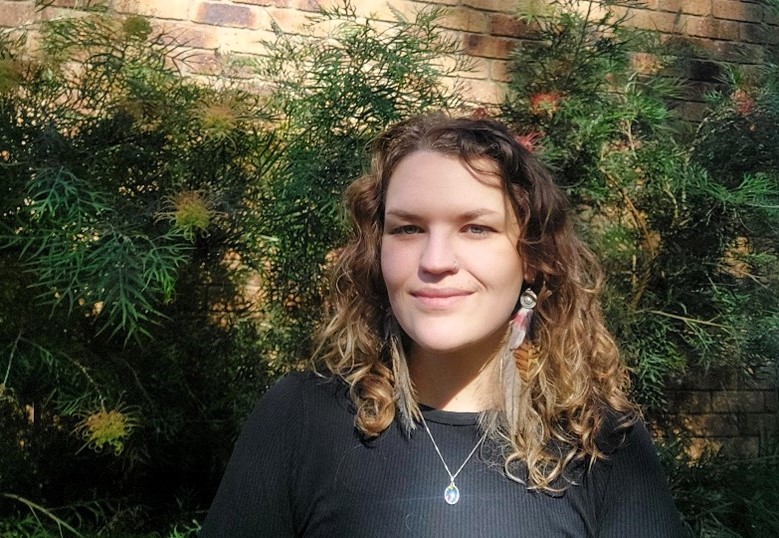NAIDOC STAFF PROFILE – DJ Ratcliffe

My name is DJ and I am a Dharawal woman who was born and raised on Badtjala country. I live in Ipswich on Yuggera land, and I work in the Churches of Christ Kenmore Campus as a Quality and Compliance Coordinator for Seniors Living Governance.
What does culture mean to you?
Culture drives how I experience the world around me in every imaginable way – spiritually, emotionally, socially, intellectually – I can attribute all of it to the stories and beliefs that have been passed down through the generations in my family. There has always been a deep sense of care for mother earth and for our fellow people in the way that I was brought up – my Grandma was a Registered Nurse and midwife, my mum is a teacher/early childhood specialist and I’ve always been in Aged Care. Care, nurturing and treating all living things accordingly has been a driving force for all of us and I connect a lot of that back to how important it is to us culturally, not just as individuals.
How do you connect to culture in your daily life?
A lot of my peers will know that I’m an artist, working mainly on hand-carved leather designs and jewellery inspired by the native plants, animals and birds around us, but I also do a lot in my daily life around caring for country and conservation. I’ve dedicated a lot of my time over the last few years to converting my property to almost completely trees/shrubs/grasses that are native to the area in an attempt to rebuild habitats for our critters (that’s not to mention also growing a few bush tucker ingredients for yours truly). I also take part in the annual bird count (October every year via BirdLife Australia’s free app) to measure my success. I’m happy to report a year-on-year increase in sassy lorikeets and bossy magpies and I love every second of it! This is something anyone can do – I highly recommend looking into any local council programs for re-habitation as they usually cost nothing to take part in, and in turn you’ll get to plant and nurture some plants that will help to create food or shelter for our wildlife.
How has your connection impacted your life journey?
Culture is a huge inspiration to me creatively, but it also uniquely impacts the way I see social matters. Like many First Nations families we’ve been impacted by the statistical “gaps” that drive the Closing the Gap targets. For me it’s as clear as day to see what sort of things can be done to make sure mob aren’t left behind – the same way the team that I work with use data to improve care outcomes for the older people that we look after. My advice to my peers is to learn as much as you can and educate yourself from trustworthy sources. If you can get your phone out to Google that guy in the movie you’re watching (because you just KNOW you’ve seen him somewhere before), then you can find out more about Closing the Gap, the Uluru Statement from the Heart, etc. and why they’re important to First Nations people and our future.
Do you have any special stories about how you celebrate culture?
The biggest inspiration for my art comes from one of the Dharawal dreaming stories. The story explains that all of our beautiful native birds were gifted their colours by the rainbow, the same way that the plants and trees were. It’s also most likely the origin of the Aussie folklore tale about how the black cockatoo is a symbol that it’s about to rain (he’s hoping to find some leftover colours from the rainbow). Through my life those colours and feathers have absolutely captivated me thanks to this beautiful story.
What aspects of the theme ‘Blak, loud and proud’ are most important to you?
I think you could ask any First Nations person and they’ll tell you that it has never felt more important to be loud and proud of who you are and where you come from. The Voice to Parliament referendum last year opened up a lot of conversations – some productive, and some challenging or confronting as a First Nations person. To me it highlighted how important education is to help people to understand the history and experiences of Indigenous Australia.
Some artists/creatives I recommend following:
I also recommend people check out upcoming Clancestry at QPAC, an arts festival with a program full of First Nations arts and culture – this year it’s being held from 30th July – 9th August.
And here are some starting points to learn more about Indigenous history, culture and key points of progress.
- Home | Closing the Gap
- Home - Uluru Statement from the Heart
- The Mabo Case – overturning the concept of “terra nullius” - The Mabo Case | AIATSIS corporate website
- The Stolen Generations | AIATSIS corporate website
- The 1967 Referendum | AIATSIS corporate website
- Serving their country | AIATSIS corporate website – the Indigenous Australians who served for this country
- Aboriginal astronomy | AIATSIS corporate website
- A piece of local QLD history – Harold Blair, Aboriginal activist and Opera singer of who the Blair electorate was named after Harold Blair - Wikipedia
